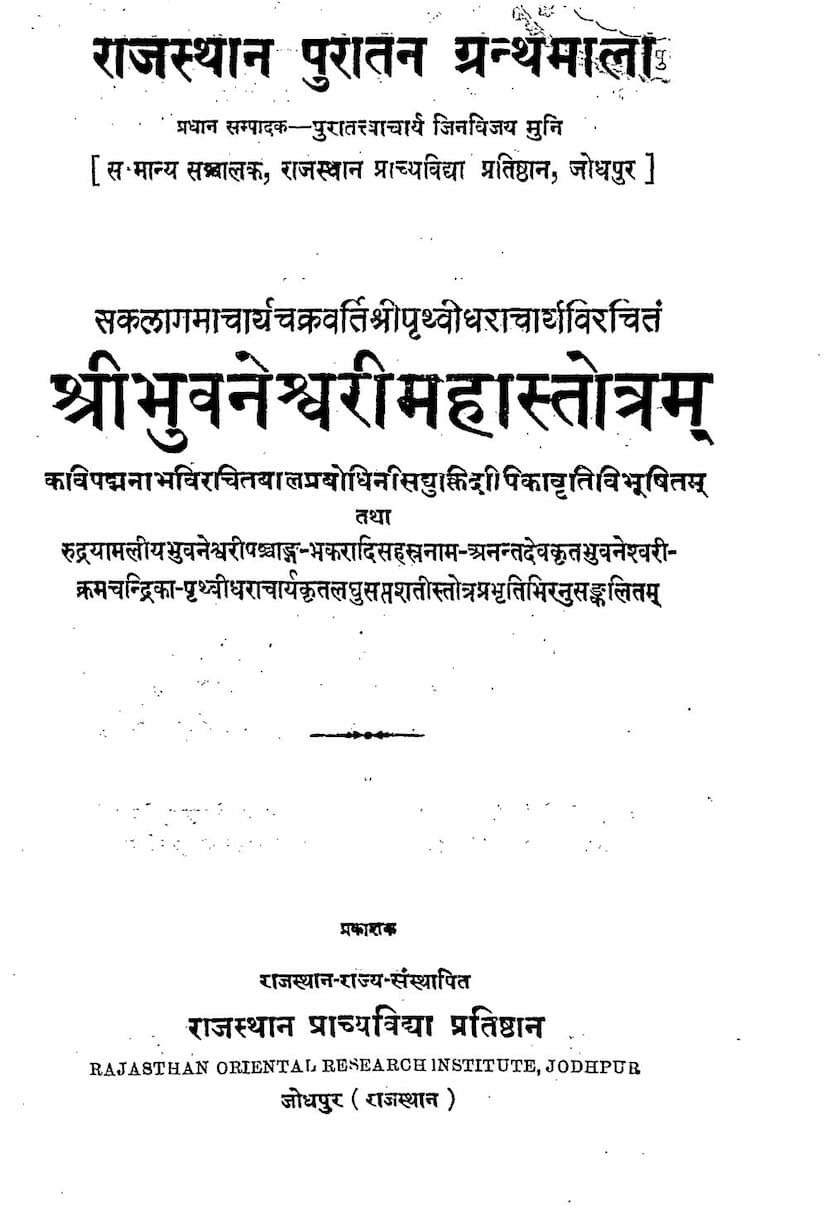Bhuvaneshvari Mahastotram
Added to library: September 1, 2025

Summary
Here's a comprehensive summary of the Jain text "Bhuvaneshvari Mahastotram," based on the provided pages:
Title: Bhuvaneshvari Mahastotram (Great Hymn to Bhuvaneshvari)
Author: Attributed to Sakalaagamacharya Chakravarti Shri Prithvidhara Acharya.
Publisher: Rajasthan Prachyavidya Pratishthan, Jodhpur (as part of the Rajasthan Puraatan Granthamaala, Granthank 54).
Editor: Shri Gopalnarayan Bahura, M.A., Deputy Director, Rajasthan Oriental Research Institute, Jodhpur.
Accompanying Works: The text is enriched with commentaries and related works, including:
- "Balaprabodini Saduktidipika Vritti" by Kavi Padmanabha.
- Works from Rudrayamala Tantra: Bhuvaneshvari Panchanga, Bhakaradi Sahasranama, Bhuvaneshvari Ashtottara Shata Nama Stotra, Bhuvaneshvari Ashtakam.
- Bhuvaneshvari Kramachandrika by Anantadeva.
- Laghu Saptashati Stotra by Prithvidhara Acharya.
Overview and Content:
The Bhuvaneshvari Mahastotram is a devotional hymn dedicated to Goddess Bhuvaneshvari, who is described as the primordial energy (Aadya Shakti) that pervcles and sustains the entire universe (Bhuvanas). The text goes into significant detail about the nature of Vāk (speech/sound) and its relationship to the divine, tracing its origins from the subtlest (Para) to the most manifest (Vaikhari) stages.
Key Themes and Concepts:
- Bhuvaneshvari as the Supreme Goddess: She is the presiding deity over the realms of existence, the source of all creation, sustenance, and dissolution. She is identified with Saraswati, the goddess of knowledge, speech, and wisdom.
- The Nature of Vāk (Speech/Sound): A substantial portion of the introductory material (Prastavik Parichay) delves into the philosophical and linguistic aspects of Vāk, as understood in Vedic and other traditions. This includes:
- Four States of Vāk: Para, Pashyanti, Madhyama, and Vaikhari, explaining their subtle and manifest forms and their connection to consciousness and divine manifestation.
- Vāk as Brahma: The text emphasizes that Vāk is ultimately Brahman (the Absolute Reality) and its power (Shakti).
- Vāk and Creation: Vāk is presented as the very medium through which creation unfolds, originating from the divine will and manifesting as the cosmos.
- Mantra and Stotra: The text highlights the significance of mantras and stotras in achieving spiritual goals. Mantras are explained as containing immense power, capable of protecting the devotee from worldly suffering and leading to liberation and the attainment of the fourfold aims of life (Dharma, Artha, Kama, Moksha).
- The Text's Significance: The Bhuvaneshvari Mahastotram is described as a mantra-laden hymn. Its recitation is believed to bring about desired outcomes and spiritual attainment. The commentary by Padmanabha is noted as being highly valuable, making the text more accessible to scholars.
- Prithvidhara Acharya: The author, Prithvidhara Acharya, is presented as a learned scholar and a proponent of Tantra and mantra traditions. He is identified as a disciple of Shankaracharya, placing him in the 8th century CE. His works are praised for their philosophical depth and devotional fervor, aimed at the welfare of humanity.
- The Structure of the Publication: The book is a comprehensive compilation that includes:
- The Main Stotra: The Bhuvaneshvari Mahastotram itself, composed in Shardulvikridita meter.
- Commentary: The "Balaprabodini Saduktidipika Vritti" by Kavi Padmanabha.
- Bhuvaneshvari Panchanga: This section includes various important rituals and texts related to the worship of Bhuvaneshvari:
- Patal (Ritualistic procedures)
- Pujapaddhati (Worship methodology)
- Bhuvaneshvari Kavacham (Amulet of protection)
- Bhuvaneshvari Sahasranama (Thousand names of Bhuvaneshvari) from Rudrayamala.
- Bhuvaneshvari Ashtottara Shata Nama Stotra (108 names).
- Bhuvaneshvari Ashtakam (Eight verses).
- Bhuvaneshvari Bhakaradi Sahasranama Stotra: From Mahatantranava.
- Bhuvaneshvari Hridayam: From Nilasaraswati Tantra.
- Bhuvaneshvari Stotra: From Rudrayamala.
- Bhuvaneshvari Kramachandrika: By Anantadeva.
- Laghu Saptashati Stotra: By Prithvidhara Acharya.
- Merits of Recitation: The text promises various benefits from the recitation of the Mahastotra, including the attainment of knowledge, eloquence, wealth, and liberation. A specific regimen of three months of devotional practice is mentioned for acquiring all knowledge through the grace of the Guru. Even regular recitation without strict vows is said to bestow poetic mastery within a year.
- Sanskrit and Jain Connection: While the title is "Bhuvaneshvari Mahastotram," and the publisher is a Rajasthan Oriental Research Institute, the presence of "Jain Education International" in the page headers and the catalog link pointing to a Jain resource suggests a potential context or repository from where this text was accessed or preserved within a Jainological framework, even though the content itself appears to be focused on a broader Hindu deity. The introduction discusses Vāk (speech) and its philosophical underpinnings, which are topics explored across various Indian philosophical traditions.
In essence, the Bhuvaneshvari Mahastotram is presented as a profound and multifaceted text for the worship and contemplation of the Divine Feminine, Bhuvaneshvari, replete with philosophical insights into Vāk and the practical guidance for her worship through mantras, stotras, and rituals.